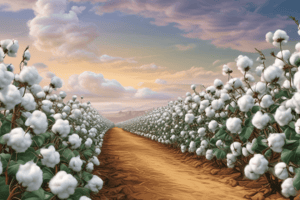Podcast
Questions and Answers
Which country is the highest producer of cotton lint per hectare based on the 1996-97 production scenario?
Which country is the highest producer of cotton lint per hectare based on the 1996-97 production scenario?
- India
- China (correct)
- USA
- Pakistan
What percentage of the world's fiber needs is met by cotton according to the provided scenario?
What percentage of the world's fiber needs is met by cotton according to the provided scenario?
- 50%
- 60%
- 30%
- 45% (correct)
Which of these products is NOT derived from cotton according to the information provided?
Which of these products is NOT derived from cotton according to the information provided?
- Edible oil
- Cushions
- Silk (correct)
- Explosives
Which of the following states in India has the lowest lint production per hectare in the 1996-97 scenario?
Which of the following states in India has the lowest lint production per hectare in the 1996-97 scenario?
What is the contribution of cotton to the GDP mentioned in the scenario?
What is the contribution of cotton to the GDP mentioned in the scenario?
What is the origin of the 'A' genome cotton species?
What is the origin of the 'A' genome cotton species?
Which of the following cotton cultivars is classified under G. arboreum?
Which of the following cotton cultivars is classified under G. arboreum?
What distinguishes the fruiting structure in cotton plants?
What distinguishes the fruiting structure in cotton plants?
During which growth stage does peak flowering occur in cotton plants?
During which growth stage does peak flowering occur in cotton plants?
What is the maximum height of the tap root system observed in cotton plants?
What is the maximum height of the tap root system observed in cotton plants?
Flashcards are hidden until you start studying
Study Notes
Cotton Overview
- Known as "white gold," cotton is crucial to the textile industry.
- Contributes 7% to India's GDP and provides jobs for 60 million people.
- Supplies 45% of the world's fiber needs and 10% of edible oil.
Importance of Cotton
- Primarily grown for lint used in textiles.
- Raw cotton has medical and surgical applications.
- Linters are utilized in cushions and pillows, while also serving high-grade paper and rayon.
- Cotton by-products include fuel from stalks and edible oil from seeds.
- Cotton cakes and meals are nutritious cattle feed.
World Production Scenario (1996-97)
- Global cotton area: 33.8 million hectares producing 19.4 million tonnes of lint.
- High yield countries:
- India: 9.2 M ha, 3.0 M tonnes (327 kg/ha)
- USA: 5.2 M ha, 4.1 M tonnes (792 kg/ha)
- China: 4.7 M ha, 4.2 M tonnes (890 kg/ha)
- Other contributors: Pakistan, Uzbekistan, Argentina, Turkey, Brazil, Turkmenistan, Greece, Australia, Egypt.
Indian Production Scenario (1996-97)
- Cotton grown in 9 Indian states with varying yields and areas cultivated.
- Largest areas and yields:
- Maharashtra: 3.1 M ha, lint 0.56 M tonnes (182 kg/ha)
- Gujarat: 1.52 M ha, lint 0.43 M tonnes (282 kg/ha)
- Highest yield state: Madhya Pradesh with 605 kg/ha.
- Northern region: Punjab, Haryana, NW Rajasthan; Central: Maharastra, MP, Gujarat; Southern: Karnataka, AP, TN.
Origin of Cotton
- Old World Cotton (genome 'A') likely originated from Southern Ethiopia, including varieties G.arboreum and G.harbaceum (desi cotton).
- New World Cotton (genome 'D') includes G.barbadense (Egyptian) and G.hirsutum (American).
Cultivars and Hybrids
- Extensive work on varietal improvement since 1900, with numerous hybrids available.
- Major hybrid varieties:
- Hirsutum: MCU series (5, 7, 9, 10, 11, 12), LRA 5166.
- Arboreum: K9, 10, 11.
- Barbadense: Suvin (Anjali), Surabi.
Plant Structure
- Root system features a tap root, capable of exceeding 1.6 m in depth.
- Shoots display monopodial and sympodial branching, differing in arboreum.
- Leaves are spirally arranged on the main stem.
- Fruiting begins as a flower bud ("square") before developing into a boll.
Growth Stages
- Germination takes 4-7 days.
- Early vegetative phase leads to squaring, occurring between 35-70 days after sowing based on variety, location, and management.
- Flowering commences 20-35 days after square formation, continuing for 60-80 days with peak flowering between 70-100 days.
- Boll development reaches 90% size within 15-18 days and matures in 25 days; fiber develops from seed-coat cells.
Climate Requirements
- Cotton thrives in specific temperature ranges which support its growth and development.
Studying That Suits You
Use AI to generate personalized quizzes and flashcards to suit your learning preferences.




